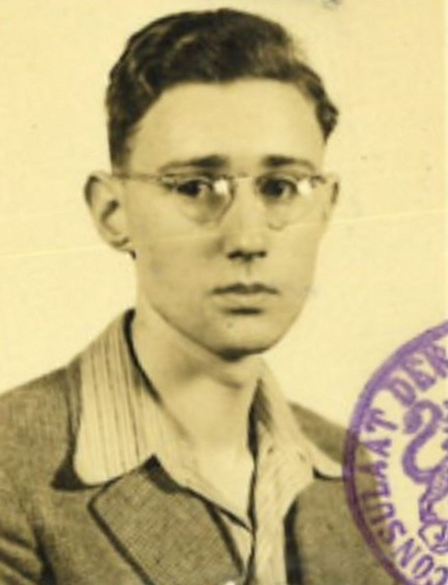
Wolfgang Bernheim
07.05.1923, Augsburg
Todestag nicht bekannt, Sakrau/Zakrzów
Residencies
Augsburg, Schaezlerstraße 17/II
Augsburg, Lutzstraße 6/II
Augsburg, Prinzregentenstraße 2/I
Augsburg, Maximilianstraße 63/III
Augsburg, Stephansplatz 6
Munich, Herzogparkstraße 3/0
Cologne, Dürener Straße 270/I
Vaals/NL, Kloster St. Benediktusberg
Last voluntary residence
Places of persecution
arrested in Vaals/NL on 26 August 1942
deported from Westerbork/NL camp on 28 August 1942
murdered in the Sakrau Forced Labour Camp in October/November 1942
Wolfgang Bernheim was born in 1923 in the Maternity Home in Augsburg.1 The building on Gögginger Strasse still exists.
Wolfgang’s father, Kurt Bernheim was the son of Maria Bernheim.2 In 1921, he had married Caroline Wallerstein of Cologne. In 1926 they were divorced.3
As early as 1926, Wolfgang‘s father married again, a non-Jewish woman from Augsburg.4
In 1928 Wolfgang‘s father cancelled his own and Wolfgang’s membership of the Jewish Community. The same day, he had his five-year old son baptized in the Sacred Heart of Jesus parish in Augsburg’s Pfersee quarter.5 At the time, the family lived on Lutz Strasse in Pfersee.6 In 1930, Wolfgang’s father was baptized and married in church.7
In 1933 Wolfgang Bernheim joined the classical grammar school at St. Stephan in Augsburg, managed by the Benedictines. He was confirmed in the monastery church on June 1st, 1933. From 1937 he stayed at the St. Stephan boarding school.8
In 1938, when Wolfgang was 15 years old, difficult times started for himself and his family. Shortly after the pogrom against the Jews, the Ministry for Education in Berlin declared that all Jewish students had to leave Jewish schools.9 Everywhere, the instruction was executed swiftly. Wolfgang‘s father could only “save his hide” by a precipitous flight to Zurich. Without an emigration permit, Wolfgang had to stay behind in Germany.10

For some months, Wolfgang’s stepmother was able to take care of him in Munich.11 Then, in February 1940, Wolfgang’s mother managed to find accommodation for her son in a Dutch Benedictine monastery close to Aachen. There, Wolfgang graduated from high school and, in 1941, joined the convent as a neophyte with the monastery name frater Paulus (brother Paul).12
Soon it turned out, that Wolfgang, even as a monk, was not safe from the Nazis. In 1940, the German Army had overrun the Netherlands within five days, and, from 1941 on, the Germans prepared to deport more than 100,000 Dutch Jews. In a telex to the Reich’s Commissioner for the Netherlands, which was read out from the pulpits on 26 June 1942, the Catholic church protested against this policy. Thereupon, in August 1942, the Reich’s Commissioner decreed that all Catholic baptized Jews be deported immediately.13 This decision also affected Wolfgang Bernheim. He was notified by the German occupying power that he had to report to them at a certain location outside of the monastery. From there he was taken to the Westerbork camp and put on a train bound for Auschwitz. 50 km ahead of Auschwitz, all male persons between 15 and 50 years of age had to leave the train. Their working power should be exploited until they were dead.14 In fall 1942, Wolfgang died in the Sakrau camp in Silesia as a consequence of the inhumane working conditions. Erich Inow witnessed Wolfgang’s death and, after the war, as a survivor, delivered the news of his death to Wolfgang’s mother.15
From 2010 on Wolfgang Bernheim has been venerated as a martyr by the Catholic church. Since then, his life has also been documented in the standard works for German martyrs and martyrs of the Augsburg dioceses.16
A fellow neophyte of Wolfgang would have been able to organize his flight to his father in Switzerland. But Wolfgang declined in order to save his monastery from potential retaliation measures. By sacrificing himself voluntarily, Wolfgang also fulfilled the abbot’s wish whom had promised obedience as a neophyte.17 Wolfgang Bernheim’s name is listed in the memorial room for Jewish holocaust victims in the Augsburg City Hall.
- StAmtA, Geburtsurkunde Nr. 1159 vom 9.5.1923 ↩
- Katholisches Matrikelamt der Diözese Augsburg, Taufschein 1930/139/20 von Curt Michael Bernheim. ↩
- LandA NRW, Heiratsurkunde Nr. 835 vom 19.12.1921. ↩
- Archiv des Bistums Augsburg, Auszug aus dem Trauungsregister Bernheim Kurt und Lehninger Anna. ↩
- Katholisches Matrikelamt der Diözese Augsburg, Taufschein 1928/85/44 von Wolfgang Bernheim. ↩
- StadtAA, MK I Curt Bernheim. ↩
- Katholisches Matrikelamt, Diözese Augsburg, Taufschein Curt Michael Bernheim; Archiv des Bistums Augsburg, Auszug aus dem Trauungsregister Bernheim Kurt und Lehninger Anna. ↩
- StadtAA, MK I Wolfgang Bernheim. ↩
- Runderlass des Reichministeriums für Wissenschaft, Erziehung und Volksbildung vom 15.11.1938, siehe Joseph Walk (Hg.), Das Sonderrecht für die Juden im NS-Staat. Eine Sammlung der gesetzlichen Maßnahmen und Richtlinien - Inhalt und Bedeutung, Heidelberg 1981, S. 256. ↩
- StadtAA, MK I Wolfgang Bernheim; StAA, AG Augsburg, Schreiben des Einwohnermeldeamts München vom 02.01.1961. ↩
- StAA, AG Augsburg, Schreiben des Einwohnermeldeamts München vom 02.01.1961. ↩
- Klosterarchiv Vaals, Klostermeldekarte von Wolfgang Bernheim. ↩
- https://www.uni-muenster.de/NiederlandeNet/nl-wissen/geschichte/vertiefung/judenverfolgung/deportationen.html (aufgerufen am 27.08.2018) ↩
- StAA, AG Augsburg, Bescheinigung des Niederländischen Roten Kreuzes vom 21.07.1955 (Nachlassakte Wolfgang Bernheim). ↩
- StAA, AG Augsburg, Erklärung von Erik Inov vom 11.11.1960 (Nachlassakte Wolfgang Bernheim) ↩
- https://thema.erzbistum-koeln.de/deutsches-martyrologium/verzeichnis_aller_martyrer/das_verzeichnis/martyrer_aus_der_NS-Zeit/ordensmaenner/benediktiner/ (aufgerufen am 27.08.2018). ↩
- Mündlicher Bericht von fr. Lambertus Moonen, Kloster Benedictusberg, Vaals NL, vom 18.5.2018. ↩
Joseph Walk (Hg.), Das Sonderrecht für die Juden im NS-Staat. Eine Sammlung der gesetzlichen Maßnahmen und Richtlinien - Inhalt und Bedeutung, Heidelberg 1981.
https://www.bundesarchiv.de/gedenkbuch/de841880 (aufgerufen am 13.02.2017)
https://www.uni-muenster.de/NiederlandeNet/nl-wissen/geschichte/vertiefung/judenverfolgung/deportationen.html (aufgerufen am 27.08.2018)

